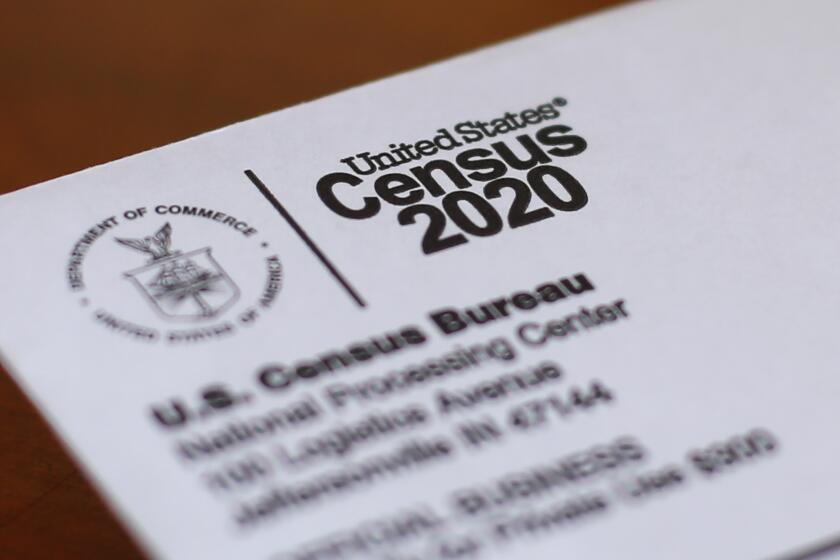Five takeaways from the U.S. census data drop

- Share via
The outlines of America’s increasingly diverse population and the data that will be the foundation of the fight for political power in the nation’s capital were provided by a report the U.S. Census Bureau released Thursday.
Here are five takeaways on what the changing demographics mean for the nation.
The U.S. saw a decline in the number of white people for the first time in its history
The country has been growing more diverse for decades — since ethnic immigration quotas were dropped in the 1960s — but the 2020 population count is the first since the census began in which the number of white people shrank. White people still make up nearly 58% of the population, the largest racial or ethnic group in the country, but their share dropped 8.6% since 2010.
Nearly 191.7 million people identify as non-Hispanic white, while 235.4 million report being only white or white as well as another racial group.
The U.S. Census Bureau releases more detailed population data that will be used to draw new congressional district maps for the coming decade.
Diverse communities are surging
The U.S. experienced its most sluggish growth since the Great Depression — 7.4% over the last decade. Much of the growth was fueled by people who are Latino, Asian and biracial or multiracial.
The Asian population grew by 36%, and the number of Latinos grew 23%. The nation is increasingly looking like California. Latinos are the second largest group after white people, making up nearly 19% of the population. Among the most intriguing findings was the 276% growth among people who identify as belonging to two or more races, up to nearly 34 million people in 2020.
The census reported that Latinos are the largest ethnic group in California, accounting for nearly 4 in 10 residents. California demographers reported several years ago that Latinos overtook whites in the state.
How people self-identify is affecting the census data
Much of the increase in all racial groups was driven by the growing number of people who report belonging to multiple races. For example, the number of Latinos who say they belong to more than one racial group increased by nearly 600%, while the number of Latinos who solely identified as being white decreased by nearly 50%.
More people are multiracial, but the increase could also be attributed in part to changing social norms about how people report their backgrounds.
California remains dominant
Although California lost a congressional seat for the first time in its history because it did not grow as fast as other states, the data released Thursday showcased the state’s dominance. It grew by nearly 2.3 million residents over the last decade.
California, with nearly 40 million residents, and Los Angeles County, with more than 10 million residents, remain the largest state and county in the nation, respectively.
Three of the nation’s 10 most populous cities are in California: Los Angeles, San Diego and San Jose. All 10 gained population, but Los Angeles’ 2.8% growth was among the most sluggish. Irvine, which gained more than 95,000 residents, was one of the nation’s 10 fastest-growing cities.
How will the data affect Americans, particularly Californians?
The data have practical impacts on all residents’ lives, including who represents them in multiple levels of government and the amount of federal funding allocated to their communities.
The census report will kick into high gear the decennial redrawing of congressional and legislative lines that will shape the politics in the nation’s capital and statehouses for the next decade.
States have varying procedures for redrawing the lines. California is among several that have an independent, bipartisan commission draw its maps. For the first time in the state’s history, it is losing a congressional seat. Because Los Angeles County grew less than other parts of the state, an L.A. County district is likely to be excised.
The U.S. Census Bureau released apportionment data, but the pandemic-induced lag has already caused ripple effects on redistricting and 2022 races.
The panel may decide to reconfigure the 25th Congressional District around Santa Clarita, a swing seat represented by Republican Rep. Mike Garcia. Boundaries in Orange County could also change, such as Democratic Rep. Katie Porter’s district, which needs to shrink in order to bring its population in line with other congressional districts.
The numbers will also be used to draw new lines for the state Senate and Assembly, county boards of supervisors, city councils, school district boards of education, water districts and other bodies that affect Californians’ day-to-day lives.
Times staff writer Melanie Mason contributed to this report.
More to Read
Get the L.A. Times Politics newsletter
Deeply reported insights into legislation, politics and policy from Sacramento, Washington and beyond. In your inbox twice per week.
You may occasionally receive promotional content from the Los Angeles Times.













